 
Mikem
Member
Username: Mikem
Post Number: 2472
Registered: 10-2003
Posted From: 68.43.15.105
| | Posted on Thursday, May 04, 2006 - 10:35 pm: |    |
Parking lot history, you ask? Why yes, that parking lot on the north side of the BC is a historic little site. I ran across this article in my files today, from a Detroit Edison employee newsletter of September 28, 1973:
quote: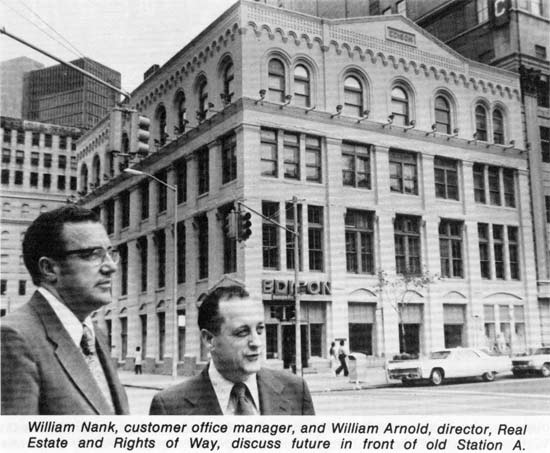
Washington Blvd. Office to be Company History
Detroit Edison’s Washington Boulevard Office is rich in history. When Edison Illuminating, the forerunner of Detroit Edison, built Station A in 1886, it became the country’s second largest power plant. Only the Pearl Street Station in New York City was bigger.
Station A’s generating equipment has been on exhibit at Greenfield Village for many years. The building has housed downtown Detroit customer offices but its service in that capacity will end Nov. 30.
Station A was the first building in the United States to be designed for the production of electricity. Later, it became Detroit Edison’s headquarters, but not before Henry Ford, an engineer for the Edison Illuminating Co., did some work during his spare time there on his invention, the automobile. Because of mounting maintenance and operating costs, the Washington Boulevard Office has been sold by the company to George and Sam Salloum, owners of Fox Parking Co., for about $300,000. A site for a new customer service office downtown is being sought, and the choices have been narrowed to two.
The new office, wherever it is, won’t have the heritage of old Station A. That building is one of the last survivors of the electric utility industry’s infancy, and also represents the start of the industry’s modern era.
When Station A was built, electric utilities were accustomed to fitting their equipment into existing structures. Station A gave architects and engineers their first chance to design a structure to fit the generating equipment. The project attracted national attention and was featured by The Electrical World as a model Edison station.
Station A went into operation Nov. 8, 1886, with two double boilers of 300 horsepower apiece; the four engines were made by Armington and Sims, a leading manufacturer of the time. The equipment was two stories high, which made it possible to construct the building on a compact 70x100 foot lot. Station A’s generating equipment was powered by electricity from the nearby Foundry Street Station. The only problem was that the alternating current (AC) from Foundry had to be converted to direct current (DC) at Station A.
Alex Dow, general manager for Edison Illuminating and later president of Detroit Edison, began running a few experiments. And in early 1900, he began replacing the noisy, dirty and space consuming boilers and engines with motorized generating equipment. The old equipment was installed at Foundry which was being expanded to meet the increasing demand for power.
By 1898, another story had been added to Station A, making it a four-story building, and steam equipment was installed. By the early l900s, the building also had become a substation and business office.
In 1916, all of the substation and steam equipment was removed. The building served as Detroit Edison’s corporate headquarters until 1922 when the General Offices Building was opened. While the building on Washington Boulevard ceased to be the operating center of the company, it remained the symbolic center. It had sentimental value and the company never changed the outside design even though the building had become a customer office. It was a Detroit landmark.
Alex Dow was one of the many who never lost his sentiment for the building, and some of the furnishings from his time are still in it. But the building -- Old Station A, one-time company headquarters, and long-time Detroit Edison downtown customer office -- with its large “Edison” sign looking out over Washington Boulevard, will have to remain nostalgia to many Detroit Edison employees. The building is being passed on to its rightful place in the histories of Detroit, the Detroit Edison Co. and the electric utility industry.
Station A on a wintry day before it was expanded:
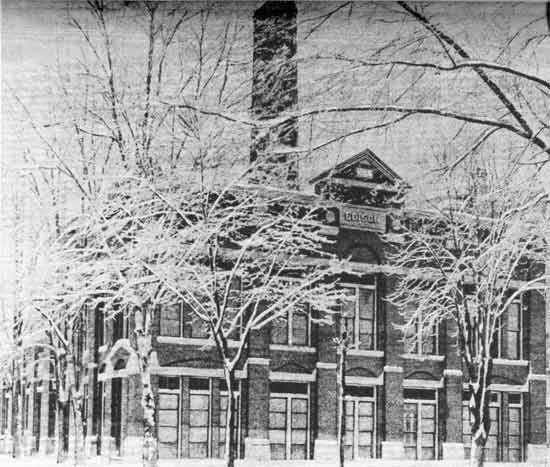
Henry Ford on the far right inside Station A:
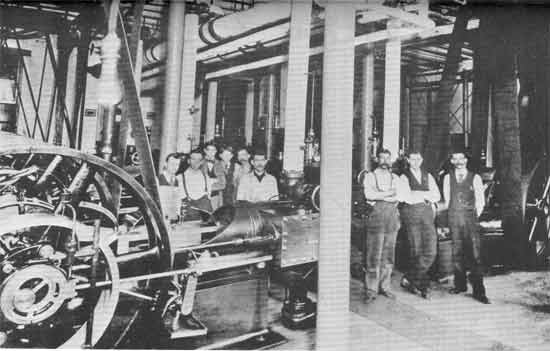 |
 
Kathleen
Member
Username: Kathleen
Post Number: 1313
Registered: 10-2003
Posted From: 69.14.122.57
| | Posted on Thursday, May 04, 2006 - 10:43 pm: |    |
Thanks, Mikem!! Very interesting!!! |
 
Bobj
Member
Username: Bobj
Post Number: 692
Registered: 11-2003
Posted From: 68.40.89.238
| | Posted on Thursday, May 04, 2006 - 10:47 pm: |    |
Great stuff - thank you! |
 
Hornwrecker
Member
Username: Hornwrecker
Post Number: 1117
Registered: 04-2005
Posted From: 63.41.40.234
| | Posted on Thursday, May 04, 2006 - 11:00 pm: |    |
A map, in case anyone needs it...

... and a photo from 1942 which I happened to have handy.
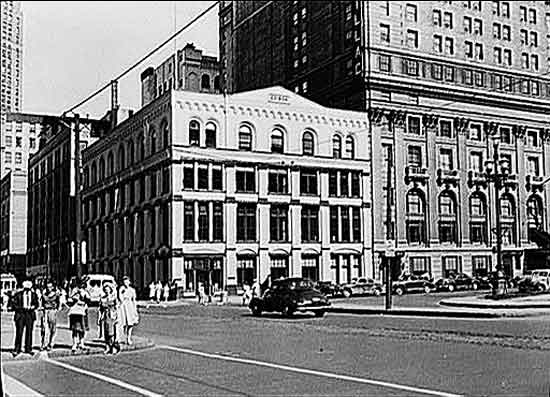 |
 
Viziondetroit
Member
Username: Viziondetroit
Post Number: 439
Registered: 11-2003
Posted From: 68.42.176.190
| | Posted on Thursday, May 04, 2006 - 11:07 pm: |    |
So much hidden history.... |
 
Hornwrecker
Member
Username: Hornwrecker
Post Number: 1118
Registered: 04-2005
Posted From: 63.41.40.234
| | Posted on Thursday, May 04, 2006 - 11:17 pm: |    |
Another view of the building (foreground right) from the 1930s.

WSU/VMC |
 
Detroitplanner
Member
Username: Detroitplanner
Post Number: 74
Registered: 04-2006
Posted From: 152.163.100.8
| | Posted on Thursday, May 04, 2006 - 11:23 pm: |    |
The old building stands in Greenfield Village. I guess old Hanked liked working there, also there is the arlington and sims manufacturing building mentioned earlier.
I see Harry Suffrin was behind it. It later merged with Hughes and Hatcher, which to all you kiddos was a local clothing store chain that was relatively high end. They had a few stores downtown; one is now where CVS stands, another is Hockeytown. And in the neighborhood shopping districts.
Most of the Malls had a Hughes and Hatcher as a major tennant as well.
Well interesting, I knew about the Edison Plant being there, but not Harry Suffrin's. Thanks for teaching me something today! |
 
Livedog2
Member
Username: Livedog2
Post Number: 193
Registered: 03-2006
Posted From: 71.10.61.35
| | Posted on Thursday, May 04, 2006 - 11:38 pm: |    |
Mikem, What a great and rich story. It never ceases to amaze me about the great wealth of knowledge of people like you on this site about the City of Detroit. Thank you!
You are "King for Day" as far as I'm concerned!

Livedog2 |
 
Eric_c
Member
Username: Eric_c
Post Number: 724
Registered: 11-2003
Posted From: 68.73.198.126
| | Posted on Friday, May 05, 2006 - 8:59 am: |    |
Keep in mind, the building at Greenfield village is a smaller scale replica. The original on Washington has joined Hudson's, the Statler, Cadillac Square Building, etc. at the landfill. |
 
Swingline
Member
Username: Swingline
Post Number: 479
Registered: 11-2003
Posted From: 172.145.0.84
| | Posted on Friday, May 05, 2006 - 11:17 am: |    |
A question for the old-timers. How did the Book Cadillac handle parking before the Edison building was demolished? |
 
1953
Member
Username: 1953
Post Number: 805
Registered: 12-2004
Posted From: 209.104.146.146
| | Posted on Friday, May 05, 2006 - 2:38 pm: |    |
Thanks to everyone for this post. Its terrific. |
 
Histeric
Member
Username: Histeric
Post Number: 696
Registered: 10-2003
Posted From: 68.61.194.66
| | Posted on Friday, May 05, 2006 - 3:07 pm: |    |
MikeM - It is posts like this that keep me coming back, in spite of my own frustrations and the barbs thrown at our site from the disenchanted on that other site. Thank you, thank you, thank you. |
 
Itsjeff
Member
Username: Itsjeff
Post Number: 5858
Registered: 10-2003
Posted From: 208.27.111.125
| | Posted on Friday, May 05, 2006 - 3:16 pm: |    |
I thought it was me that kept you coming back : ) |
 
Histeric
Member
Username: Histeric
Post Number: 698
Registered: 10-2003
Posted From: 68.61.194.66
| | Posted on Friday, May 05, 2006 - 3:26 pm: |    |
Actually, no offense, but I prefer manrooter. |
 
Itsjeff
Member
Username: Itsjeff
Post Number: 5859
Registered: 10-2003
Posted From: 208.27.111.125
| | Posted on Friday, May 05, 2006 - 3:28 pm: |    |
I'm going to hitch onto Mike M's thunder and mention that it's been a full year since we first started discussing the Great Downtown Construction Mystery of 1932. We still never got a definitive answer.
https://www.atdetroit.net/forum/mes sages/36206/44026.html |
 
Hornwrecker
Member
Username: Hornwrecker
Post Number: 1121
Registered: 04-2005
Posted From: 63.41.8.114
| | Posted on Friday, May 05, 2006 - 5:49 pm: |    |
An earlier photo of Washington Blvd before the current Book-Cadillac was built. Across the street is Reliable Furniture, which is next to what looks like the Connolly for Mayor campaign HQ, and the Book Tower is under construction.
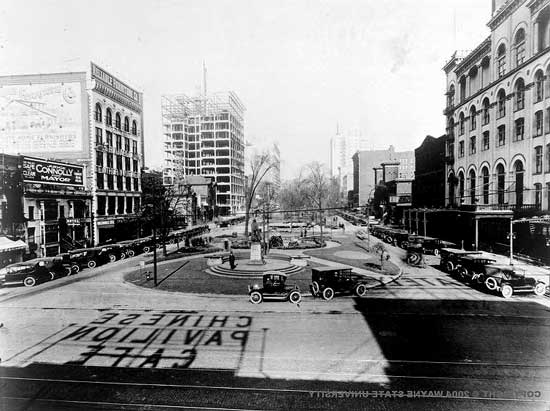
An enlargement of the Edison Bldg shows an Edison sign over the sidewalk.
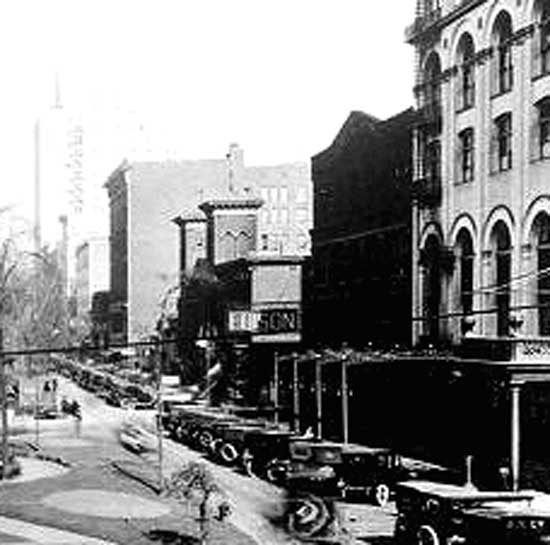
This was another photo in WSU/VMC that was reversed, so it took me awhile to figure it out. The shadow in Michigan Ave reads Chinese Pavilion Cafe. |
 
J_stone
Member
Username: J_stone
Post Number: 304
Registered: 10-2003
Posted From: 63.77.247.130
| | Posted on Friday, May 05, 2006 - 6:23 pm: |    |
Awesome!
I work for Edison and have been reading Killowatts in Action: A History of The Detroit Edison Company. I never knew until reading that book, where the original headquarters stood. That site has a ton of history, yet nobody really knows about it. The book has a lot of Detroit history in it in general.
I have been meaning to contact our photo department, and see what kind of old pictures we have. I would love to see the inside of the G.O. building, before it was horribly remodeled and that cross way over 2nd Ave was built and covered up the old main entrance. Interestingly enough, our address is still 2000 Second Ave, even though it's not really an entrance anymore. |
 
Jsmyers
Member
Username: Jsmyers
Post Number: 1688
Registered: 12-2003
Posted From: 209.131.7.68
| | Posted on Friday, May 05, 2006 - 6:29 pm: |    |
What was the "China Pavillion Cafe?"
And I think that construction was the "building" part of the Book Tower and Building. |
 
Mikem
Member
Username: Mikem
Post Number: 2478
Registered: 10-2003
Posted From: 68.43.15.105
| | Posted on Friday, May 05, 2006 - 7:04 pm: |    |
Thanks for the props...Histeric, don't let the bastards wear you down - here nor there!
Jeff, your mystery is on my "to do" list for the next visit to the Burton.
Let's see what else I have...
From the employee newsletter of December, 1936:
quote:THE NEW SERVICE BUILDING
by PAUL G. HEIDMAN
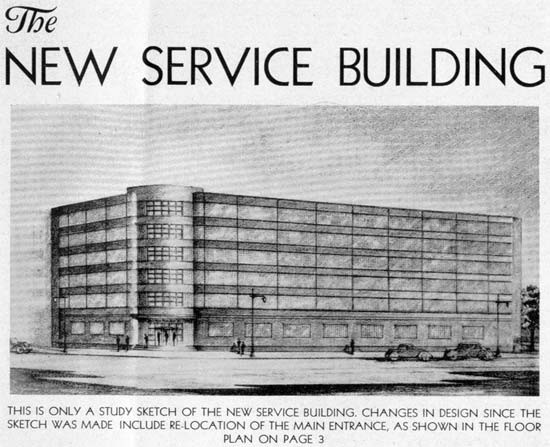
Next summer, long after the 17,000 cubic yards of dirt have been hauled away and the steam shovels have retired from the big hole along Third Street between Beech and West Elizabeth, there will stand on this site the New Service Building. Built of glass brick and terra cotta, it will be thoroughly modern in every detail.
The foundations and substructure are all that have been approved. This work is scheduled for completion at once, so that the superstructure may be begun as soon as practical in the spring.
The present plans call for a six story building, 248 feet long and 120 feet wide, covering a greater amount of ground area than the present Service Building and having almost the same amount of usable space. It will be windowless and air-conditioned throughout. The frame will be of re-enforced concrete flat slab construction.
The main entrance will be on Third Street just south of the Elizabeth Street corner. Service entrances are to be located on Elizabeth and Beech Streets, so that people may enter the building without going around to the Third Street side.
Since this structure is to house service departments as well as offices, a loading dock will extend along the entire east side of the building. Part of this dock will be about twenty-four inches high -- the most convenient height for paneled delivery trucks such as those used by the Sales Department delivery service. The rest of the dock will be about thirty inches high, and will accommodate larger trucks. A canopy will extend over this dock as protection during bad weather.
Heavy pedestrian traffic between the two Service Buildings will call for a tunnel or concourse connection.
The purpose of this new building is to provide for centralization of some departments and to relieve congestion in others. At the same time it should enable the Company to serve the public with increased efficiency. For instance, the centralization of the appliance repair and delivery service will shorten the time required to repair and return appliances to the customer, and will also eliminate a number of delivery runs. With the Customers’ Accounts, Collection, Meter and Meter Reading departments all in the same building, and each department with adequate, modern working space, customer records will require less transporting from place to place. Moreover, some departments will have sufficient room to make improvements of operation they have had in mind for some time. Such changes will naturally improve the service.
Present plans for occupancy of the new building are as follows:
Sales - Appliance Repair, except building machine room
Basement Floor
117 Employees
Sales - Cooking School, Assembly Room, Display Shop, Delivery Service, locker and shower room
1st Floor
50 Employees
Meter Department
2nd Floor
147 Employees
Collection Bureau
3rd Floor
256 Employees
Meter Reading, Meter Demand and Records, Central Heating, Crane and Elevator Inspection, Customers’ Accounts
4th Floor
207 Employees
Drafting and Surveying and Construction
5th Floor
279 Employees
Not yet assigned
6th Floor
250 Employees
Although the use of glass brick in a project of this kind is quite new, the idea has certain well known advantages. Daylight filtering through glass brick is soft and diffused, virtually eliminating shadows. Since this building will have no light courts, and the distance from the outside wall to the corridor is about forty-five feet, it is essential that as much light as possible be thrown back into the space near the corridor.
Heat and cold that will penetrate glass brick is estimated to be about half the amount penetrating an equal area of window glass. A glass brick area is equal to an eight-inch wall in keeping out the cold in winter time. Employees working next to the walls should not be bothered by cold drafts, as in the ordinary building.
It is possible to carry a high relative humidity in such a building as ours will be. In silk mills, where it is important to maintain a high relative humidity, as high as 70% has been held without objectionable condensation. Of course, we will not have to carry any such humidity, but sufficient moisture can be maintained for the health and comfort of employees with out having water dripping down the walls.
Employees in the building will be unable to see what is going on outside. They may hear the fire engines, but there will he no windows from which they can look. Nor will they be able to find out if the flag is up at Navin Field, except by telephone! For the same reason it may be impossible to tell the condition of the weather. The Hershey Chocolate Company has a windowless building in Hershey, Pennsylvania, with solid masonry walls. In order that the employees may know what the elements are doing, they have installed a series of signal lights. One signal stands for “fair and sunshine,” others for “cloudy,” “rain,” and so on.
Although the glass brick will admit day-light in our building, some similar system may also be installed here. The Hershey Company signals are located beneath the clocks throughout the building which, seems a reasonable location, for people do look at clocks!
Three passenger elevators and one freight elevator will be necessary to serve the new building. These will be of the modern, push-button, self-leveling type. The freight elevator will be adaptable to the carrying of passengers during rush hours.
The lighting of the new building is being given special consideration. The very nature of the work to be done in the various areas makes this necessary. Certain portions of it will be used for display and sales purposes, others for general office work, parts for exacting tasks, such as drafting and repair work. In addition, a small assembly loom is being provided, making possible the use of stage lighting equipment. The illuminating requirements for these various activities will each be considered in detail and adequate facilities supplied for specialized needs.
At the present writing, detailed description of the final installation is not available. However, some idea regarding the standards to be set up may be obtained from the fact that each overhead outlet will he wired for not less than 1000 watts illumination and that the general office areas will have four such openings in each hay of twenty-four by twenty-four feet.
Provisions will be made for adequate wiring capacity and, naturally, modern lighting equipment will be used including the latest development in Mazda lamp construction, the 1000-watt Bi-Post type. In short, the entire building will represent the latest practice in the lighting art.
If you will refer to the accompanying plan of the first floor, you will note a Sales assembly room. This room is provided for meetings and demonstrations of the Sales Department, so that educational and development work can he carried on. The Service Building Assembly Room is too large for many of these meetings and is not especially equipped for their use. The new facilities will be an aid to better work. The room will be equipped with motion picture booth and a stage, and it will seat about 215 people, with sufficient space around the sides of the room to maintain permanent displays. On one side there may be range, refrigerators and other household appliances; on the other, modern lighting and industrial appliances and equipment.
The cooking school will contain a model kitchen and will seat about sixty people. This school, used by the Home Service Group, will make a suitable place for research, as well as for educating housewives and dealers’ salesmen in modern electric cooking.
The display shop, located on the southwest corner of the first floor, will provide well-lighted, pleasant quarters for the men who build the window displays for the Commercial Offices.
Good lighting will enable the employees in this new building to work without eyestrain, while air conditioning will insure a cool place in summertime and a warm place in winter, as well as pure, fresh, filtered air to breathe the year ‘round.
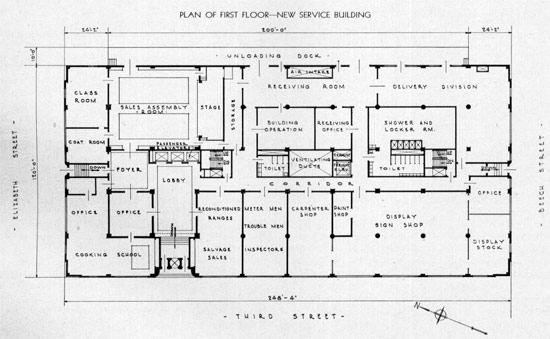
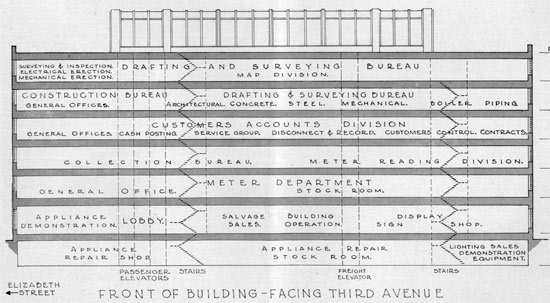
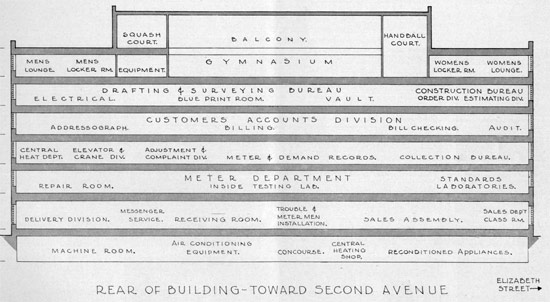
Progress photos from 1937:
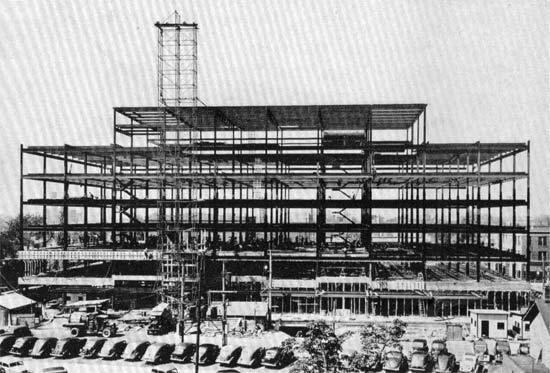
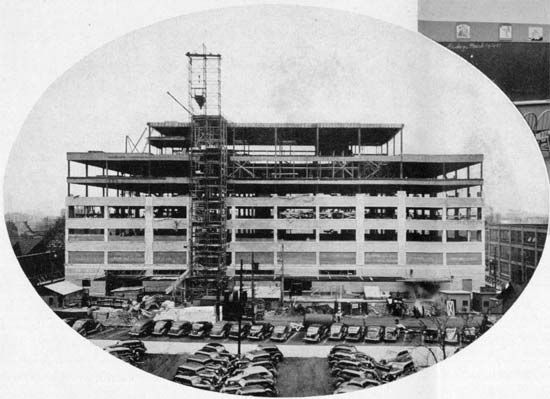
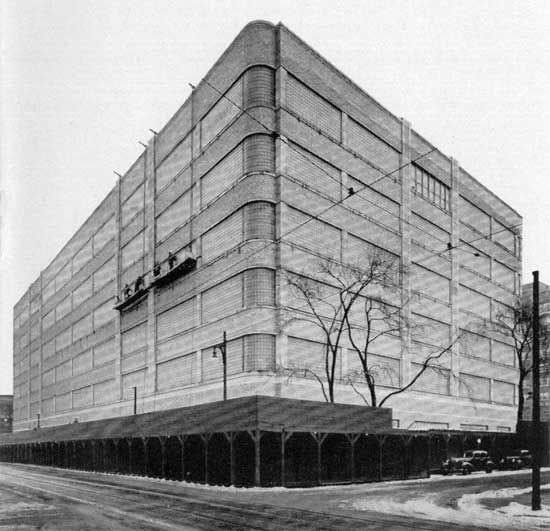
The building in this article is the Service Building, not to be confused with the General Office, a block to the east:
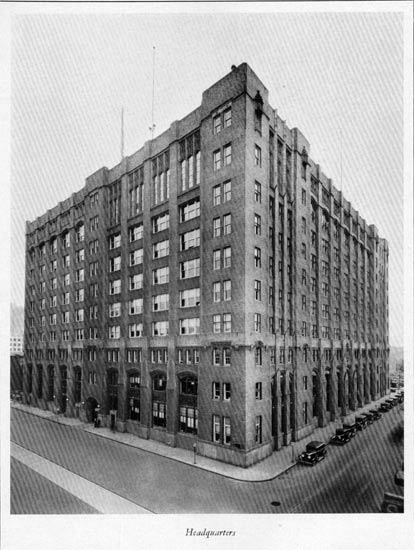 |
 
Iheartthed
Member
Username: Iheartthed
Post Number: 54
Registered: 04-2006
Posted From: 68.40.50.194
| | Posted on Friday, May 05, 2006 - 9:29 pm: |    |
Ummm... Henry Ford did not invent the automobile. |
 
Psip
Member
Username: Psip
Post Number: 1080
Registered: 04-2005
Posted From: 69.246.13.131
| | Posted on Friday, May 05, 2006 - 9:42 pm: |    |
I had long ago heard a rumor that the Edison facility on Livernois had a 1 Farad capacitor. Does anyone know if this is true? It supposedly was the only one in the world. |
 
Hornwrecker
Member
Username: Hornwrecker
Post Number: 1122
Registered: 04-2005
Posted From: 63.41.8.104
| | Posted on Friday, May 05, 2006 - 10:56 pm: |    |
Psip, you just wanted to know where the 1 farad is, so you could trick your little brother into touching the leads. Fool me once...
I finally found a photo that I misfiled of what might have been an update to the Detroit Edison #1. Horizontal Curtis wheels, of a type I've never seen before (and I've seen many a turbine).


I forgot where I found this, not one of the usual sources. |
 
Mikem
Member
Username: Mikem
Post Number: 2479
Registered: 10-2003
Posted From: 68.43.15.105
| | Posted on Friday, May 05, 2006 - 11:41 pm: |    |
I suspect those were installed in the first Delray power plant. From the book J_Stone is reading, Kilowatts at Work, by Raymond Miller:
quote:In spite of all speed and pressure, the Delray plant seemed an interminable time in building. The Curtis turbines, ordered so far in advance from General Electric, proved to be the cause of distressing delay. Each of these machines had to be manufactured, assembled, and tested in the New York factory. Then they were disassembled for shipment and rebuilt at Delray. The first reassembly did not start before July 5, 1904, and the second was even more delayed. Delray did not serve its full purpose until 1905, when four generators were in place...
The purpose of a power house is to translate the energy of coal into the electric energy on the wires of the system. The reciprocating engines which predated Delray No. 1 produced electricity at the cost of five pounds of coal per kWhr. The first new plant which was planned for Delray would save the 25 cents a ton drayage to haul coal to Station A (Washington Blvd) and would produce power at an estimated three pounds per kWhr. The promise of this prodigy of efficiency justified the proposed scrapping of all old equipment and the creation of a totally new generating system. This story of obsolscence and renewal was repeated in the years which followed.
Mounting demand justified the installation, as rapidly as possible, of the full capacity of the first power plant. Delray's original four vertical turbo-generators were rated at 3,000 kilowatts each; in 1906 the fifth and last such machine was added. These were four pressure-stage Curtis turbines of 600 r.p.m., each direct-connected to a twelve-pole alternator generating at 4,600 volts and 60 cycles. These turbo-generators cost $75,000 each, plus an additional $25,000 each for installation.
Delray No. 1
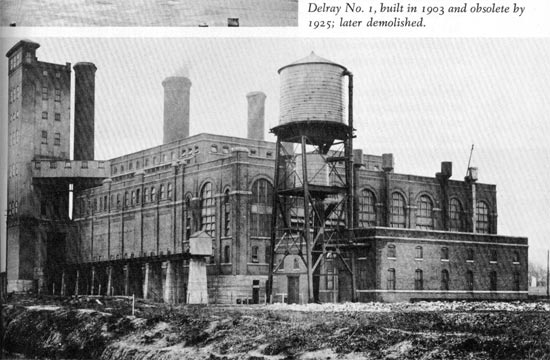 |
 
Barnesfoto
Member
Username: Barnesfoto
Post Number: 1955
Registered: 10-2003
Posted From: 66.2.148.160
| | Posted on Friday, May 05, 2006 - 11:47 pm: |    |
thanks for the cool pics. I remember that building from childhood trips downtown. I remember when it was demoed too.
According to my mother, it had been preserved because the then-president of Detroit Edison (Walker Cisler?) had a strong preservationist streak. When he left DE, the building went down. |
 
Hornwrecker
Member
Username: Hornwrecker
Post Number: 1127
Registered: 04-2005
Posted From: 63.41.8.104
| | Posted on Saturday, May 06, 2006 - 1:03 am: |    |
I suspect those were installed in the first Delray power plant.
Thanks for the Delray info. I didn't think that the window arrangement matched the topic, but it was too interesting not to post. The #1 plant threw me though, I didn't know that the Washington Blvd was #A.
Looking at those vertical Curtis wheels, it is difficult to imagine the loads the bearings were under, even when not operating, let alone the gland seals. Yikes! |
 
Mikem
Member
Username: Mikem
Post Number: 2486
Registered: 10-2003
Posted From: 68.43.15.105
| | Posted on Saturday, May 06, 2006 - 2:13 am: |    |
How would that bearing load differ from a generator at a hydro plant? Aren't those frequently mounted vertically? Probably much smaller though.
Delray 1 (1903-1933) was complimented by Delray 2 (1907-1957), built next door
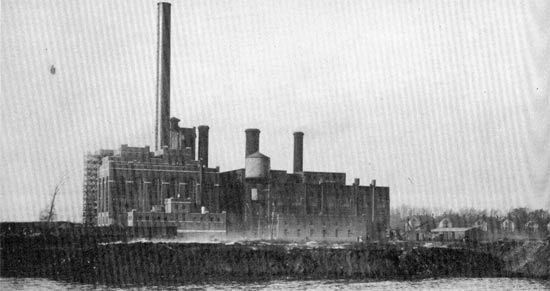
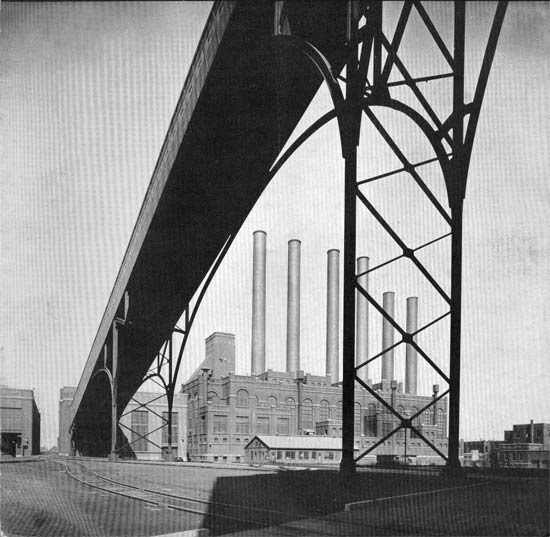
and Delray 3 (1929-?):
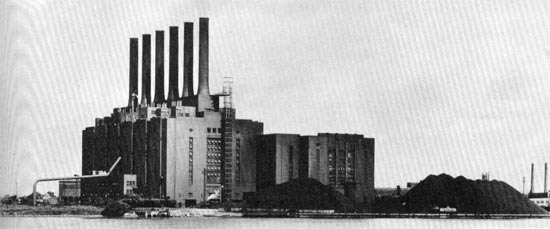 |
 
J_stone
Member
Username: J_stone
Post Number: 305
Registered: 10-2003
Posted From: 69.246.28.55
| | Posted on Wednesday, May 10, 2006 - 1:01 am: |    |
MikeM - Incredible! Thank you so much.
Barnes - Those buildings are still there man. I work in them. |
|






















